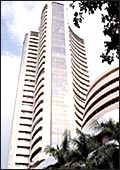|
Gurgaon-based
Barnali and Debraj Mazumdar were saddled with a sudden debt crisis
after the latter met with a near-fatal accident while travelling
to New Delhi. Already burdened with a home and a car loan, the
Mazumdars dipped into their meagre savings to fund Debraj's hospitalisation
bills, but fell short by Rs 1 lakh. Out of desperation, Barnali
funded part of the bill with another loan-a no-questions-asked
personal loan. The result: the Mazumdars are now paying monthly
installments of over Rs 35,000. What's worse, with Debraj bed-ridden
and Barnali the only earning member for now, the Majumdars are
facing a debt crisis.
Gaurav Taneja, 31, a Mumbai-based marketing
professional, bought a house for Rs 55 lakh, partly financed through
a bank and by borrowing about 50 per cent from friends. Taneja's
repayment to the bank and his friends strips him of about 80 per
cent of his income, leaving little in hand to take care of his
personal expenses.
What do these folks have in common? They
are overwhelmed with debt-the former due to an unfortunate circumstance
and the latter by overspending. That leaves little or no room
for investing money or saving cash. More importantly, it also
leaves them both increasingly vulnerable to a further credit squeeze.
Easy Money
These days getting credit
is easy. It wasn't too long ago that you received a cold call
from a call centre announcing a better rate for you, was it? In
such situations, it's easy to get tempted and go for a loan even
when not needed. Banks started pushing retail credit aggressively
six years ago, bombarding you with different schemes for housing
or car loans and at the same time introducing innovative and flexi-payment
plans to make the repayment seem easy on you. Off late, it's the
no-questions-asked personal loan that is gaining popularity where
banks promise instant cash up to Rs 10-50 lakh within 24 hours-all
with the intention of getting your business, but perhaps unintentionally
driving you deeper into debt.
Little wonder then, the loan numbers from
the Reserve Bank of India tell a startling tale for the borrower.
Home loan outstanding surged by 44 per cent to Rs 1,86,429 crore,
while credit card debt zoomed by 59 per cent to Rs 9,177 crore
and education loans nearly doubled to Rs 10,057 crore, as on March
2006.
 |
| Kaustav Dhar (R), 33, and Ananya, 31,
financed a house and car three years back through some expensive
borrowings. But as incomes grew, they increased the EMI payables
to reduce the outstanding tenures. It's been tough, but worth
it. |
| HOME LOAN: Rs 29 lakh EMI: Rs 44,000
CAR LOAN: Rs 4 lakh EMI: Rs 20,000 |
But the truth is that debt repayments can
sometimes go awry, and that's what you should take care to avoid.
Much of the borrowing community today seems ill-prepared to deal
with an emergency like losing a job or meeting with an accident.
"High-paying jobs are available and people are getting fatter
salaries and can afford to pay their loans," says Mumbai-based
financial planner Gaurav Mashruwala. "But one should remember
that factors like economic slump, retrenchment and lay-offs, health
problems and even accidents leading to handicaps can rally through
things getting out of gear," he continues. "It can be
painful when people lose their job and are unable to make payments.
The situation is much like companies unable to service debts due
to a decrease in revenues in a slowing market. That harms the
image."
Even RBI Governor Y.V. Reddy acknowledged
on the bank's Foundation Day in September that a debt trap could
be lurking somewhere. "With the changing growth dynamics
of the economy, it is not difficult to envisage situations where
certain segments of the population become susceptible to excessive
borrower optimism or even to vicissitudes in the economic environment.
Such susceptibility could also arise from unforeseen shocks or
emergencies that make repayment difficult."
But given that in this day and age, debt
has percolated into our everyday lives, it's better to manage
debt prudently than to allow it to snowball into a crisis.
 |
"Loans ought to
help you buy only basic items of necessity and not luxury
products"
Gaurav Mashruwala
Mumbai-based Financial Planner |
For Needs Only
The first rule, as they say, is the cardinal
one: avoid borrowing. Till a couple of years back, Indians were
quite averse to borrowing, preferring instead to save for a house
or a car. Even buying white goods like a TV or a scooter was carefully
deliberated. But the trend is slowly beginning to change.
If you have to borrow, make sure that it's
for a necessity and not luxury. Home buying perhaps falls into
this category. The rate of interest on home loans is the cheapest
at around 9 per cent per annum and combined with tax breaks on
interest costs, the effective rate reduces to around 6.3 per cent
in the highest tax bracket for a loan of up to Rs 17 lakh. Says
financial planner Mashruwala: "Loans ought to help you buy
only basic items of necessity and not any luxury products. It's
always advisable to go for loans to buy items of necessity and
get out of the loan at the earliest."
You can also add loans to build assets, rather
than fritter the money away on a holiday. If possible, try to
gauge the returns from the assets you are building, which should
ideally be more than the interest cost of the loan.
For most, perhaps, a car is a luxury, but
for the select few for whom a car is a necessity, it's prudent
to keep the borrowing down to minimum, and pay off the loan as
quickly as possible. Although car loans don't cost too much, with
effective rates hovering around 10 per cent due to discounts,
cars are depreciating assets and, therefore, the lesser you pay
for them in overall interest costs, the better.
 |
"One should not take
a home loan where the emi exceeds 40 per cent of the net salary"
Mukesh Gupta
Director, Wealthcare Securities |
Keep an Eye on Liabilities
Usually when people borrow, they focus on
the monthly installment and whether they can afford to repay it,
instead of looking at the entire liability holistically. It may
be cheaper to look at a Rs 13,495 monthly installment rather than
the Rs 15 lakh home loan behind it. But compare the loan to assets
rather than against monthly installments. Says Mashruwala: "Individuals
are often borrowing in a manner whereby their outstanding liabilities
are much more than 50 per cent of their assets." Ideally,
if a person has assets worth Rs 40 lakh, his net loan principal
should not exceed Rs 20 lakh, a rule which only a few tend to
follow.
Assess What you Can Pay
Housing finance companies have a thumb rule
beyond which they will not finance your house: the monthly installment
should not exceed about 40 per cent of your net take home income.
"One should not take a home loan where the EMI exceeds 40
per cent of your net salary," says Mukesh Gupta, a Delhi-based
wealth manager and Director, Wealthcare Securities. So, if your
net package is around Rs 50,000, your EMI could go up to Rs 20,000.
But individuals often add a car loan and some credit card outstanding
to their loan amounts and the overall repayment exceeds 60-70
per cent of the net package.
But Mashruwala prefers to err on the side
of caution with good reason. "EMI of all loans combined should
not exceed 20 per cent of your earnings, unless there is a home
loan. With a home loan, all the EMIs combined should not add up
to 40-45 per cent of your monthly cash inflows."
Rules For Smart Borrowing
When taking a loan, do not lose
sight of basic principles. |
»
Monthly installments of all loans combined should
not exceed 20 per cent of your total monthly earnings-unless
there is a home loan
» If you
have a home loan, combined installments should not be more
than 40 per cent of your monthly earnings
» Ideally,
outstanding liabilities should not be more than 50 per cent
of assets
» Borrow
to fund assets like real estate, but avoid loans for travel
and luxury products
» Get
out of a loan as soon as possible
» Borrow
for a shorter duration even if the EMI is high
» Do not
borrow only for tax benefits
» Do not
hesitate to pre-pay loan, even if there is a penalty |
Sometimes increasing your monthly installment
can go a long way in reducing your liabilities quickly. Ananya
and Kaustav Dhar bought a flat in Mumbai in 2003. In June this
year, Kaustav, Vice President of a domestic airlines firm in Delhi,
doubled the EMI and bought down the tenure of their housing loan
from 20 years to around 14 years, thus getting rid of their liabilities
quickly.
Pre-pay Whenever Possible
It's essential to bring down the outstanding
liabilities, especially in a longer duration loan where the outstanding
principal is higher, such as a home loan. Mushruwala says one
should not hesitate to repay a loan, even if there are penalties
for pre-payment. "The word penalty sounds unpleasant to many,
but the numbers when matched would definitely point to more consoling
results."
In the initial years, a significant chunk
of monthly installment goes towards interest costs, while a small
portion goes towards principal, hence the necessity to repay whenever
possible so that the outstanding loan amount comes down faster
than you expect.
The biggest risk most individuals tend to
ignore is the high-cost loans. The outstanding on a credit card
loan seems small, but the interest costs are steep. Credit card
loans are the costliest followed by personal loans or a holiday
loan, which tends to cost around 18-24 per cent per month.
Also, don't bunch loans. Keep track of your
loans and clear off one after another. It may seem overwhelming
to clear off all the loans simultaneously. And lastly, try and
keep about three extra monthly installments handy to tap into
whenever an emergency arises.
Performance
Pays
Not all
equity mutual funds outperform the markets. Here's what made the
successful ones tick.
By Mahesh Nayak
 |
"Funds with high
concentration over large caps have remained in limelight"
R. Swaminathan
Associate Vice President & National Head (Mutual Fund),
IDBI Capital |
When
mutual fund distributors sell funds, they usually quote the past
performance of the fund. True, all but one equity fund have given
positive returns ranging between one and 53 per cent since January
this year. In bull markets, especially this one with all but a
few stocks rising, it's no secret that most equity fund investors
would have made money for investors. But the real test of a fund
manager's stock-picking skills can be gauged only when the funds
they manage outperform the major market indices.
Looking at the past performance over the
last year, the returns story seems far from ordinary. Most funds
have turned out ordinary performances as out of 128 diversified
equity funds, only 18 have managed to beat the Sensex, or about
one in seven funds have beaten the Sensex. In other words, the
chances of you being in an outperforming fund at the beginning
of the year would have been just 14 per cent. But since the time
the market began to rally from June (after the crash), about 36
out of 128 funds have outperformed the Sensex. Says Hemant Rustagi,
Chief Investment Officer, Wiseinvest Advisors: "Rising large-cap
stocks have been the main reason for underperformance of most
funds."
This year, till date, the Sensex has been
volatile, but the overall returns have been encouraging. From
a level of 9,400 in the beginning of the year, the Sensex surged
to 12,671 on May 11, but selling pressure on concerns of rising
oil prices and interest rates brought the index down to a level
of 8,800. However, impressive corporate performance pulled back
the Sensex to its all-time high of 13,678 levels.
 |
"Rising large-cap
stocks have been the main reason for underperformance of most
funds"
Hemant Rustagi
CEO, Wiseinvest Advisors |
If performances in both the rallies between
January and May and from June to October and the year- to-date
performances are considered, only 11 funds have come up trumps
(see Top Performers). These 11 funds rose more than 42 per cent
since the beginning of the year and over 49 per cent since the
Sensex low of 8,799, beating the broad-market index. One key aspect
which went in favour of these funds was their exposure to the
right sectors and stocks last year. "Funds with high concentration
over large caps and infrastructure funds have remained in limelight,"
says R. Swaminathan, Associate Vice President & National Head
(Mutual Fund), IDBI Capital.
Some funds that have managed to outperform
the market are the Tata Infrastructure Fund, which has predominantly
invested in the infrastructure space, a favourite segment in the
market in recent times. Tata Infrastructure's overall performance
since the beginning of the year has been 52 per cent. This was
followed by Reliance Regular Saving Fund and Franklin India Opportunity
Fund. Both of them have delivered an overall return of 52 per
cent each. In fact, these funds also made a strong comeback, gaining
55 per cent, 63 per cent and 70 per cent in the recent market
bounce back (see Top Performers), thus improving their overall
performance this year.
Much of the gains in the last year have come
from the large-cap space. For Tata Infrastructure Fund, out of
the 55 stocks (corpus size of Rs 920.5 crore), the top 10 stocks
accounted for 39 per cent (Rs 373 crore) of the total corpus of
the fund. BHEL, L&T, Siemens, Grasim Industries, acc, Reliance
Industries and Gujarat Ambuja Cements are some of the top picks
in the fund.
On the contrary, for Reliance Regular Saving
Funds, the top 10 stocks account for 69 per cent (Rs 79 crore)
of the total corpus of Rs 115 crore. The fund has gained mainly
due to its holding in Infosys Technologies, Reliance Industries,
TCS, HLL, L&T, Ashok Leyland and Suzlon Energy. These six
stocks account for over 53 per cent of the fund. Many other diversified
funds that have outperformed the Sensex had greater exposure towards
large cap stocks and in stocks related to infrastructure. "This
clearly indicates that investors have to diversify their portfolio
such that they should always be in a position to participate in
the market upside," says Rustagi.
| Ringside View |
»
Sixty-two out of 124 funds were outperforming
till May 2006 in the first market rally
» But
only 18 funds have managed to outperform the Sensex to date
this year
» Last
year, equity funds returned an average of 28 per cent, lower
than 41.5 per cent of the Sensex
» Only
11 funds managed to beat the markets consistently over the
two market rallies and overall during the year
» Funds
that had an exposure to infrastructure and engineering sectors
and large-cap companies came out trumps |
What To Do Now?
But there's a caveat: past performance is
never an indicator of the fund's future performance. Besides,
investors can never really time the market and hence, a good strategy
in this market is to stay invested for a longer period of say
around three years and invest regularly. Also, looking for the
next out-performer is easier said than done as active fund managers
could change their stock allocations depending on their outlook
for stocks and sectors.
But as the market is expected to favour the
larger, but higher growth companies, there's a big chance that
funds that have a favourable sector exposure towards core economy
sectors like infrastructure, engineering and consumer areas, could
do well in the future. Sticking to the ones that have invested
in stocks on the growing economy should be a reasonable strategy
for investing in funds. Says Nilesh Shah, CIO, Prudential ICICI:
"Our generation is indeed quite fortunate. We are able to
participate in the bull run that our previous generations weren't
fortunate enough to witness. The strong economic growth will drive
the market, investors should remain calm and stay invested in
the right sectors and stocks."
The Hot Sectors
The markets
are making new highs and the bulls don't mind. A look at what's
in store.
By Clifford Alvares
 |
|
BANKS
|
 |
|
OIL & GAS
|
 |
|
MEDIA
|
 |
|
HEALTHCARE
|
One
doesn't have to look far for reasons for this bull market because
that's no secret: foreign investors. This is the fourth straight
year they have invested more than $8 billion (Rs 36,000 crore).
Besides, new foreign investors are coming in droves with as much
as 171 new registrations this year taking the count of foreign
investors to 993 till date.
With more buyers, valuations continue to
expand. At last count, the market was hovering at a P-E of 22.57.
By contrast, on May 10, before the crash, the P-E was a touch
lower at 22.15. Despite talk of overstretched valuations, with
huge fund flows into the market, they don't seem to be much of
a hindrance. Says Jigar Shah, Vice President, KR Choksey Securities:
"There's liquidity that's driving this market. Earnings growth
has been captured in the valuations."
All Round Growth
The spotlight continues to remain on the
large caps as foreign investors prefer the more stable and liquid
counters. But this market has also been as much a sector story
as it has been a large cap story. The core economy sectors such
as cement, steel and engineering have been gaining ground on the
back of new opportunities in the construction space, particularly
as new highways and real estate development projects get commissioned.
Sectors that have fuelled the rally are the banking sector, the
convergence stocks, technology services companies and capital
goods.
Since June, the BSE Bankex has been the star
performer giving returns of 74 per cent, as against the Sensex's
50.4 per cent (see The Buzzing Sectors). Next up was the BSE teck
index, comprising telecom, media and it companies, which returned
70 per cent driven by consumption and outsourcing. The evergreen
it outsourcing sector continues to attract investor attention
as a large number of high-priced outsourcing deals take place
propping the BSE it index by 66 per cent.
Among the notable laggard to the Sensex is
understandably the oil and gas sector, which has been bogged by
the high oil prices and the subsidy burden. With the issuance
of oil bonds, however, the sector has recovered, and the BSE Oil
& Gas index gained 38 per cent. In the bottom of the heap,
the FMCG sector has gained 25 per cent in the last five months.
This bull market started in metals and commodity
stocks where the increased prices resulted in improved performance
of these companies. Slowly but steadily the rally trickled to
other sectors such as auto and construction and then the engineering
segment. Part of the rally lately has been fuelled by the growth
in the banking business. Credit offtake has been strong this year
at 28 per cent growth year-on-year, besides valuations were low
in the single digits.
Over the next few months, though, it's necessary
to put a finger on the sectors that could perform better. As the
economy is growing strongly, some sectors could be potential money
spinners than others. The trick, of course, is to figure out from
which companies the earnings momentum appears strong. In some
cases, such as construction and engineering, the answer lies in
order books. Besides, some sectors that are a play on consumption
could prove to be potential winners. Rajesh Jain of Pranav Securities
prefers aviation and media. "The aviation and media sectors
look attractive," says Jain, adding, "Over the next
three years, it's a good market to be invested in."
Once you zoom in on a sector, look for signs
of undervaluation and earnings expansion in specific stocks and
then narrow down to a select few companies from about six-to-seven
sectors. It's one of the ways forward.
NEWS ROUND-UP
Jobs To Riches
Info Edge (read: Naukri) makes a splash on
listing. Is the valuation too high?
It's
been a dream debut for Info Edge, the company that runs job site
naukri.com. On the first day of listing, the stock closed at a
towering Rs 594, landing its investors a whopping 85 per cent
gain on the offer price of Rs 320, pushing its market capitalisation
to Rs 1,621 crore. By contrast, revenues for fy 2006 stood at
Rs 82 crore. Against net profits of Rs 13.29 crore last year,
the company's historical price earnings ratio stands at 122 times.
But the fast-growing jobs portal could see profits double each
year for the next two years, which should result in a p-e of about
60 times for FY 2007 and 30 times FY 2008. Is this too high?
For starters, Info Edge is the first online
portal to offer shares in India and it received a fabulous response
to its IPO which was oversubscribed a whopping 56 times, as is
the craze overseas with online companies. The company owns the
job portal naukri.com, which runs online classifieds and also
earns subscription revenues for its databases. Job search is among
the fastest growing businesses and it contributes more than 90
per cent of the company's revenues currently. Besides, it is also
investing in new ventures Jeevansathi.com (matrimonial site) and
99acres.com (real estate site).
Since the company is debt-free and there
are no variable or production costs, the operating margins of
such businesses are high. Says Rishi Maheswari, Research Analyst,
Networth Stock Broking: "For a company like this, there are
no variable costs and it's a growing business, so it can command
a higher valuation." But there's also a lot of media frenzy
with similar online companies overseas and much of the future
returns for shareholders will depend on how earnings growth pans
out.
-Clifford Alvares
The
Threat Of Phishing
A guide to beat net fraudsters who're fishing
for your finances.
By T.V. Mahalingam
 It's
innocuously called Phishing but this internet fraud can clean
out your bank account. Phishing is the latest scam perpetrated
by fraudsters who send e-mail messages to glean personal information
like internet banking user ids, passwords, credit and debit card
numbers, and other bank account information from users. Using
this information, the fraudsters access bank accounts and subsequently
transfer the money out of them. It's
innocuously called Phishing but this internet fraud can clean
out your bank account. Phishing is the latest scam perpetrated
by fraudsters who send e-mail messages to glean personal information
like internet banking user ids, passwords, credit and debit card
numbers, and other bank account information from users. Using
this information, the fraudsters access bank accounts and subsequently
transfer the money out of them.
What's more disturbing is the fact that this
form of online fraud has caught up in India. According to PhishTank,
an anti-phishing service started by us-based Opendns, India belongs
to the axis of evil of phishing websites. India hosts the third
most number of phishing websites in the world (8 per cent) only
preceded by the US (24 per cent) and South Korea (14 per cent).
"The problem is very serious. Earlier fraudsters used viruses
to cripple systems, but now they have gone smarter by focussing
their attacks on personal users for financial gain," says
Manoj Mansukhani, Head (Technology & Global Marketing), MicroWorld
Technologies.
| SAFETY TEST |
|
DOS
» Log
on to a site by typing the proper URL in the address bar
» Before
providing your user ID and password ensure that the page
displayed has https:// which signifies a secure website
and not just http://
» Use
different passwords for bank, credit cards and non-banking
sites, and periodically change the passwords too
» Access
internet banking facilities preferably on laptops or desktops
that you generally use. Passwords can be stolen on PCs by
monitoring key strokes
» Provide
personal details over phone/internet only if you have initiated
a call
» Banks
never ask you to verify your account information through
e-mail
DON'TS
» Click
on any link which has come through e-mail from an unexpected
source
» Give
any information on a page that has come through a pop-up
window
» Provide
your password over the phone or in response to an unsolicited
request over e-mail
» Click on links to your bank's website;
instead key the address into your browser yourself
Source: Various banks
|
The fraudsters often approach unsuspecting
victims through e-mails which purport to be credible communication
from banks. For example, State Bank of India customers recently
received an e-mail which claimed to be a security upgrade from
the SBI's customer service team. The fraudulent mail claimed that
the bank was announcing a new security upgrade "for better
and secure banking service, against any fraudulent activities."
The mail further went on to state this: "Due to this recent
upgrade, you are requested to update your account information
by following the reference below." Often the mails and the
sites they lead to have the look and feel of the bank.
So, how does one avoid getting phished? Three
simple thumb rules, says Madhabi Puri-Buch, Senior General Manager,
ICICI Bank. "One, never type your id, password or any other
information on a site that you have not visited yourself. Two,
use internet banking facilities only on a pc or a laptop that
you normally use or consider safe. And finally, when in doubt,
ask the bank," adds Puri-Buch. She also adds that phishing
attempts despite their regularity are not causing serious financial
damage as the customers are becoming increasingly aware. ICICI
recently launched a campaign in an attempt to educate customers
about banking securely. Banks are also beefing up their levels
of security by asking users for details like mobile numbers, random
digits of their debit card number, etc.
Winter
Wonderlands
Looking for the exotic and don't mind the
expense? Here are four of this season's must-visits.
By Deepti Khanna Bose
 |
ARCTIC ADVENTURE, STOCKHOLM
BUDGET: Rs 4 lakh per head, including airfare
WHEN: November 1, 2006-February 28, 2007
DURATION: 6 nights & 7 days
THINGS TO DO: Check out the Northern Lights, explore
the wilderness of Lapland, visit the Ice Hotel and Ice Church
and the Sami Reindeer Farm
LOG ON TO: www.swedenvisitor.com
THE ICE HOTEL, QUEBEC, CANADA
BUDGET: Rs 4.5 lakh per head, including airfare
WHEN: October 31, 2006-March 31, 2007
DURATION: 6 nights & 7 days
THINGS TO DO: Take a chill pill, switch off and enjoy
the experience
LOG ON TO: www.icehotel-canada.com
|
It's
time to chill out. And holiday planners are taking this season
to heart with a host of adventures to soothe your palate, free-up
your mind and tempt you with an ever-growing list of exotic holidays
tailor-made to suit your wallet. There are plenty of holidays
to choose from, if cash is not a constraint.
But before you are lured into that ever-expanding
list of holidays, BT Money has looked into some of the most luxurious,
indulgent and unique vacation spots for you to visit this winter.
These four destination spots have been chosen for two reasons:
for starters, they are far removed from work and city-life, both
for the mind and for the body, and secondly, though they are exotic,
they do not cost a million dollars, but more in the vicinity of
a few thousand.
First up on our list is a six night- seven
day Arctic adventure, which begins from the moment you land in
Stockholm. The package includes a guided tour of the Swedish capital,
flying to Kiruna on a quest to witness the magnificent glory of
the Aurora Borealis, a visit to the Ice Hotel and Ice Church in
Jukkasjärvi, and a visit to the Sami Reindeer Farm for a
day of fun and frolic with Rudolph and all his elk; the package
also includes a fascinating tour of the Swedish countryside, castles
and manors. All this and a fabulous memory to savour for the rest
of your days, for the fairly princely sum of Rs 4 lakh per head,
including airfare. For more details, log on to www.swedenvisitor.com.
 |
PALACE ON WHEELS
BUDGET: Rs 1.5 lakh per head, including airfare
WHEN: November 1, 2006- January 31, 2007
DURATION: 7 nights & 8 days
THINGS TO DO: Visit monuments and palaces, elephant,
camel & boat rides and glorious sightseeing
LOG ON TO: www.palaceonwheels.net
INTERCONTINENTAL THE GRAND RESORT,
GOA
BUDGET: Rs 1.45 lakh per head, including
airfare
WHEN: November 1, 2006-March 31, 2007
DURATION: 7 nights & 8 days
THINGS TO DO: Visit churches & forts, be a beach-bum,
sample the eclectic cuisine and night life
FOR INFORMATION: Ask your travel agent
|
Next up on our list, we zoom in to one of
the most exotic, most unique, and most languid holiday destinations
in the world. At approximately Rs 4.5 lakh (including airfare)
per head, you can have the divine opportunity of spending six
nights and seven days in a real life fairy-tale-winter-wonderland:
The Ice Hotel, Quebec, Canada. The package includes a complimentary
cocktail 'in the rocks' (in view of the fact all the beverages
are served in glasses made out of ice!) every day, access to the
Nordic-style Relaxation Space equipped with hot tubs and sauna,
a hot beverage served in bed the moment you wake up, a full buffet
breakfast, a new bottle of Quebec's famous Ice Cider (in ice glasses)
every day, and one of the most beautiful, fascinating rooms you
have ever seen in your life, considering that everything there
is made out of ice, including the furniture. And of course, for
all those who want to go skiing, the hotel will be only too happy
to arrange it for you at actuals. For more information and bookings,
log on to www.icehotel-canada.com.
For those who don't want to stray too far
from home, there's always the novel Palace On Wheels on its splendid
and enchanting royal journey through the bygone era of the erstwhile
Maharajas. Though times have changed and the winds have shifted,
the Palace On Wheels cruises along in royal style, the kind only
the Maharajas of yesteryears could have perpetuated and enjoyed.
The package includes full catering (it has a world renowned menu
and chefs), guided sightseeing tours in deluxe carriages, entrance
fees for monuments, elephant and boat rides. This perfect blend
of relaxation and cultural activity comes with a price tag of
Rs 1.5 lakh (including airfare) per person for seven nights and
eight days; for more information and for bookings, log on to www.palaceonwheels.net.
| Before You Travel Overseas |
»
Carry addresses and phone numbers of Indian embassies
of the countries you will visit
» Take
travel insurance valid for the entire trip
» Fill
in the contact details at the back of your passport for someone
who can be contacted in an emergency
» Be aware
of immigration and customs controls of the country you are
travelling to, including any necessary visas
» Tell
someone where you are going and when you expect to return;
leave itinerary and contact details of where you might be
in case of emergency
» Take
along back-up funds, such as traveller's cheques, some cash
or credit cards
» Buy
a good travel guide that includes basic information on local
laws and customs
» Insure
all your vaccinations are up-to-date; inquire about any other
suggested medical advice by visiting your healthcare provider |
And finally the perfect destination for all
seasons, but especially for winter-Goa. Here, we recommend the
winter package at the InterContinental The Grand Resort. Set on
86 acres of lush elegantly landscaped beachfront gardens on the
western coast of Goa, straddled between two rivers, it offers
an 880-metre-long exclusive beachfront, giving the resort a unique
advantage of both seawater & freshwater recreational opportunities.
At Rs 1.45 lakh (including airfare) for seven nights and eight
days, it's definitely worth the money. The hotel's exclusive virgin
beach sports white sand, and every so often you will see a turtle
coming on shore to nest. For those interested in a wild time,
hey, it's Goa, and the party scene is cool. For bookings and to
avail the special winter package, contact your travel agent.
So, for all you folks who can't remember
the last time you took a vacation, take your pick, book your trip,
pack a bag, and go!
VALUE-PICK
Thermax
Power Packed.
As
the focus on efficiency increases, more companies are opting for
solutions that save costs. One company that provides comprehensive
solutions in different areas such as waste heat recovery, water
treatment and recycling, captive power plants, and is well poised
to capture the growth coming its way is Thermax. Demand for captive
power plants from the cement industry is strong while the steel
industry continues to require waste heat recovery systems to improve
efficiencies. Besides, with companies expanding capacities, Thermax's
products such as boilers are finding more takers.
In many ways, this company has pricing power
for its products because of the stronger demand for its products
from user industries. Thermax recorded sizeable increase in orders
during the June-September quarter, pushing up its order backlog
to Rs 2,973 crore, from Rs 2,670 crore in the previous quarter.
Besides, this pricing power has also allowed the company to improve
its margins to 13.7 per cent in the second quarter (Sept. 2006),
which can be sustained with prices of raw materials such as steel
fairly stable.
Besides, the company's low gearing has resulted
in high returns on capital at over 40s. That, combined with the
proposed investment of about Rs 400 crore, makes the stock look
attractive at these levels. At the current price of Rs 343, it's
quoting at around 24 times its FY07 earnings. Says Priyanko Panja,
Vice President, Edelweiss Secuirities: "It is at the centre
of corporate capital expenditure which is taking place in the
economy, with a high demand for its products."
Over the long haul, there is considerable
scope for the stock to appreciate making it a good addition to
the portfolio.
-Clifford Alvares
Capital for Markets
RBI's new norms on capital exposure are unlikely
to affect markets.
 From
January 1, 2007, banks that have an exposure to the capital markets
may have to change the way they finance the capital market. The
Reserve Bank of India (RBI) released new norms for banks saying
that the aggregate exposure of a bank to the capital markets should
not exceed 40 per cent of its net worth. But the new norms aren't
likely to impact the capital markets in any significant way. From
January 1, 2007, banks that have an exposure to the capital markets
may have to change the way they finance the capital market. The
Reserve Bank of India (RBI) released new norms for banks saying
that the aggregate exposure of a bank to the capital markets should
not exceed 40 per cent of its net worth. But the new norms aren't
likely to impact the capital markets in any significant way.
There aren't too many public sector banks
that fund capital market operations, and those that do are some
of the private players. Hitherto banks were allowed to lend up
to 5 per cent of their total advances to fund capital market operations,
with the new norms the advances to the capital market segment
are likely to reduce. But the market observers are unperturbed.
Says Rajesh Jain of Pranav Securities: "The market does not
depend on such small funding. Earlier this year, margin funding
for brokers was withdrawn but that did not affect the market"
Those looking for IPO finance may have to
contend with a lesser amount. Banks will not be able to finance
IPOs worth more than Rs 10 lakh per individual. Besides, loans
against shares or debt overall is restricted to Rs 20 lakh. What's
more, banks have been directed to get a declaration from borrowers
detailing loans and advances against shares to ensure compliance
to the new rules. If you have borrowed heavily against shares,
you have to pare down your exposure. But for markets overall,
its business as usual.
-Clifford Alvares
|
















 I
I

 From
January 1, 2007, banks that have an exposure to the capital markets
may have to change the way they finance the capital market. The
Reserve Bank of India (RBI) released new norms for banks saying
that the aggregate exposure of a bank to the capital markets should
not exceed 40 per cent of its net worth. But the new norms aren't
likely to impact the capital markets in any significant way.
From
January 1, 2007, banks that have an exposure to the capital markets
may have to change the way they finance the capital market. The
Reserve Bank of India (RBI) released new norms for banks saying
that the aggregate exposure of a bank to the capital markets should
not exceed 40 per cent of its net worth. But the new norms aren't
likely to impact the capital markets in any significant way.